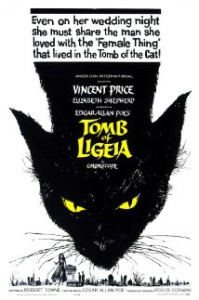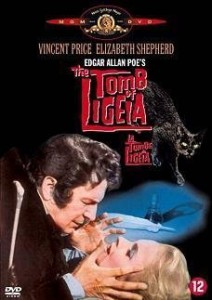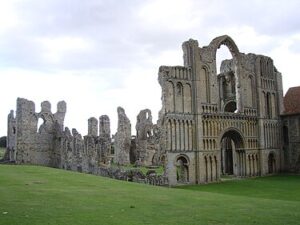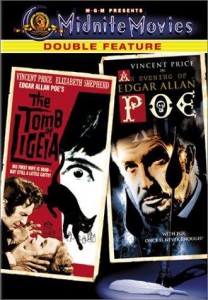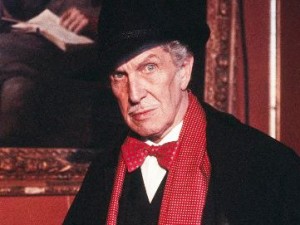The Tomb of Ligeia **** (1964, Vincent Price, Elizabeth Shepherd, Oliver Johnston) – Classic Movie Review 2,843
Shot in England and released in 1964, The Tomb of Ligeia, the final film in director Roger Corman’s cycle of eight Edgar Allan Poe-inspired movies (begun with House of Usher in 1960) is a creepily dark and superbly atmospheric gothic affair.
Supposedly based on the short story Ligeia by Edgar Allan Poe, it is written by Robert Towne, who most famously penned Chinatown, for which he won the 1975 Oscar for Best Original Screenplay. Towne recalled: ‘I worked harder on that than on anything I think I have ever done. And I still like that screenplay. I think it’s good.’ He read all Poe’s work and decided to expand on the short story by using Poe’s themes such as mesmerism and necrophilia.
Vincent Price is on magisterial form as Verden Fell, a grieving Victorian widower haunted by an obsession with his dead wife, the Lady Ligeia (Elizabeth Shepherd), who turns into a cat, and drives a wedge between him and his second bride, the Lady Rowena Trevanion (also Shepherd). The couple live reclusively in a small part of a half-ruined abbey with the manservant Kenrick (Oliver Johnston).
Price gives a most sombre turn and looks at his most gravely impressive in his black clothes, top hat and dark glasses, symbolically emphasising his emotional darkness and blindness. Corman wanted Richard Chamberlain to star as he thought Price too old for a character who was in his late 20s, but Price’s casting was a condition of AIP investing in the film. Corman told Towne: ‘Don’t worry, Bob, I’ve got Marlene Dietrich’s make-up man!’, who gave Price a wig and more makeup than usual to make him look younger.
Anyway, it may be that Price is too old for the original concept of his character, but he is magnificent.
Towne said: ‘I think it would have been better if it had been with a man who didn’t look like a necrophiliac to begin with. I felt the role called for an almost unnaturally handsome guy who the second wife could easily fall in love with.’
[Spoiler alert] There’s a rousing, though somewhat conventional, Corman horror climax that leads, once again in one of his movies, to the hero being engulfed by fire.
Arthur Grant’s Eastmancolor cinematography is a major asset, filming largely on location in a 12th-century ruined Norfolk priory, though the interiors were shot at Shepperton Studios, near London. Castle Acre Priory was founded in 1089, with the church consecrated between 1146 and 1148, and dissolved in 1537 and its ruins are in the care of English Heritage.
Corman said: ‘[Robert] Towne wrote the film as a love story and that’s how we wanted it. This was the first Poe movie to be filmed on natural locations. For the first time we brought the world of Poe into the world of reality.’
Also in the cast are John Westbrook, Derek Francis, Richard Vernon, Ronald Adam, Frank Thornton, Denis Gilmore and Penelope Lee.
It was released in the UK by Anglo-Amalgamated/ Warner-Pathé in November 1964 and in the US in January 1965.
It cost only $150,000 and was successful. Corman recalled: ‘All of the Poe films made money but Tomb of Ligeia made the least amount. I think it was because the series was just running out of steam and also because it was overly complicated.’
Corman summed it up as ‘one of the best Poe pictures and Vincent’s performance in the film was very good. It was simply a matter of age. His casting did change the orientation of the film quite a bit.’
Corman granted Martin Scorsese permission to use a scene in Mean Streets.
The Tomb of Ligeia is directed by Roger Corman, runs 81 minutes, is made by Alta Vista Productions, is distributed by Anglo-Amalgamated/ Warner-Pathé, is written by Robert Towne, based on the short story Ligeia by Edgar Allan Poe, is shot by Arthur Grant, is produced by Pat Green, and is scored by Kenneth V Jones.
The cast are Vincent Price as Verden Fell, Elizabeth Shepherd as Rowena Trevanion/ Ligeia, John Westbrook as Christopher Gough, Derek Francis as Lord Trevanion, Oliver Johnston as Kenrick, Richard Vernon as Dr Vivian, Frank Thornton as the butler Peperel, Ronald Adam as Clergyman, Denis Gilmore as Livery Boy, and Penelope Lee as Maid.
The Roger Corman Poe cycle:
House of Usher (1960)
The Pit and the Pendulum (1961)
The Premature Burial (1962)
Tales of Terror (1962)
The Raven (1963)
The Haunted Palace (1963)
The Masque of the Red Death (1964)
The Tomb of Ligeia (1964).
Robert Towne
Robert Towne (born Robert Bertram Schwartz; November 23, 1934 – July 1, 2024) started off writing films for Roger Corman, and acting in them too.
Towne wrote the screenplay for the Corman-financed Last Woman on Earth (1960), in which Towne also played one of the lead roles. The following year he starred in the Corman-financed Creature from the Haunted Sea (1961). He then wrote the screenplay for The Tomb of Ligeia (1965) and the script for Corman’s Western A Time for Killing (1967).
© Derek Winnert 2015 Classic Movie Review 2,843
Check out more reviews on http://derekwinnert.com

